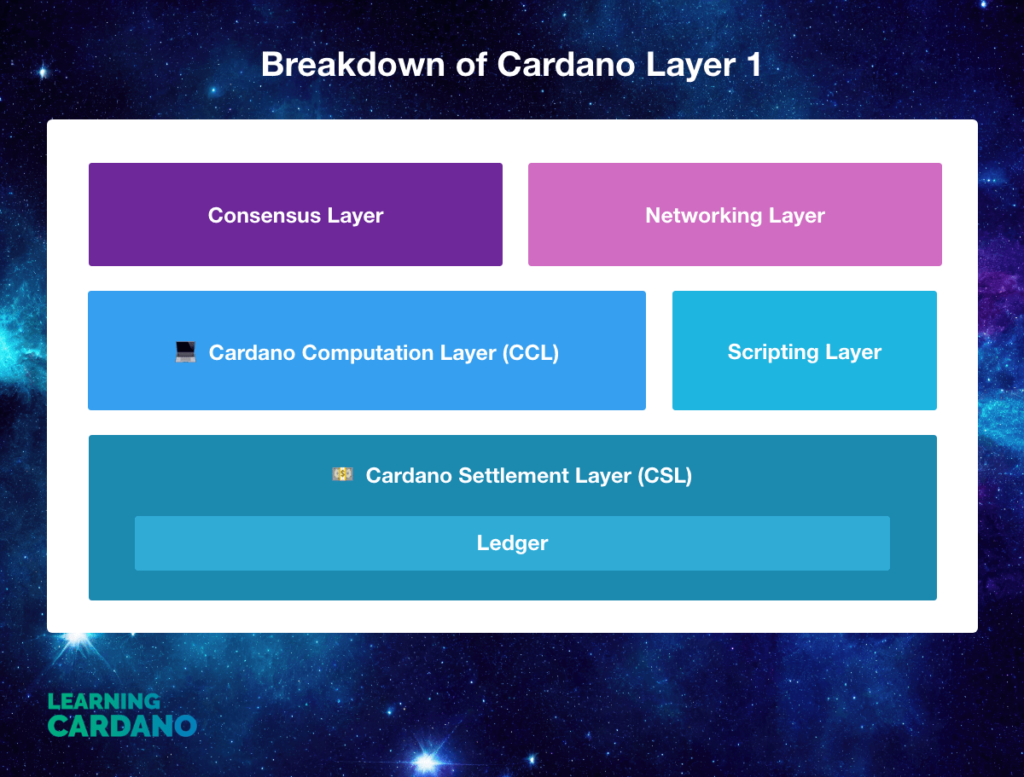Cardano is a blockchain platform that stands out for its scientific approach and its unique, layered architecture. To truly understand how Cardano works and why it’s considered one of the most advanced blockchain platforms, it’s essential to dive into its core structure: the Cardano Settlement Layer (CSL) and the Cardano Computation Layer (CCL). These layers are what make Cardano both secure and flexible, enabling it to handle everything from basic transactions to complex smart contracts. In this article, we’ll explore these layers and how they work together, as well as the potential for additional Layer 2 solutions.
Authors Note ✏️
The layers of Cardano were the first “gotcha” for me in learning Cardano that left me a little confused. I found a lot of articles and infographics from both the Cardano team and external stakeholders referencing layers to mean a few different things. There were also references to Cardano having 4 layers and not 2 layers. I believe this stems from “Layer 1” being comprised of multiple “sub-layers” (the settlement layer and the computational layer). I’ve also seen reference to the “consensus” and “networking” layers—not yet sure where this applies. Will update.
UPDATE: I was correct in regards to “sub-layers” and have created an infographic below as my best depiction of what this looks like so far. All of these sublayers work together to make up Layer 1. I believe the confusion in terminology is based on the evolution of the technology. CSL & CCL we’re originally the only two layers that existed when the journey began.

The Cardano Settlement Layer (CSL)
The Cardano Settlement Layer (CSL) is the foundation of the Cardano blockchain. It’s where all the basic operations occur, specifically the transfer of ADA, Cardano’s native cryptocurrency. The CSL is responsible for:
- Transaction Settlement: The CSL records every transaction made with ADA. Whether you’re sending ADA to a friend or receiving it from a business, the CSL ensures that the transaction is securely and accurately recorded on the blockchain.
- Security and Integrity: By using a proof-of-stake (PoS) consensus mechanism called Ouroboros, the CSL maintains the security and integrity of the blockchain. Stakeholders participate in validating transactions, and the CSL ensures that these transactions are tamper-proof and immutable.
- Speed and Efficiency: The CSL is optimized to handle transactions efficiently, ensuring that they are processed quickly and at a low cost. This makes ADA an effective means of transferring value across the network.
The CSL is essential for the basic functionality of Cardano, serving as the ledger where all transactions are recorded and verified. It ensures that ADA transactions are secure, fast, and reliable.
The Cardano Computation Layer (CCL)
While the CSL handles the simple transfer of ADA, the Cardano Computation Layer (CCL) is where the more complex magic happens. The CCL is responsible for:
- Smart Contracts: The CCL allows for the creation and execution of smart contracts. These are self-executing contracts where the terms are directly written into code. When certain conditions are met, the contract automatically enforces the agreement, whether it’s the transfer of assets, the execution of services, or any other programmable task.
- Decentralized Applications (dApps): Beyond simple contracts, the CCL supports decentralized applications (dApps). Developers can create and deploy dApps that run on the Cardano blockchain, leveraging the security and decentralization of the network while offering innovative services to users.
- Flexible Programming: Cardano’s CCL uses Plutus, a powerful programming language based on Haskell, for writing smart contracts. This allows for precise and secure code, reducing the risk of bugs and vulnerabilities. Additionally, Cardano offers Marlowe, a domain-specific language designed to simplify the creation of financial contracts.
- Formal Verification: One of the standout features of Cardano’s CCL is its emphasis on formal verification. This means that smart contracts can be mathematically proven to behave exactly as intended, providing a level of security and assurance that’s particularly valuable for applications handling significant financial transactions.
The CCL makes Cardano much more than just a payment system. It enables the platform to support a wide range of applications, from financial services to supply chain management, all within a secure and decentralized environment.
Layer 1 and Layer 2 in Cardano
When discussing blockchain technology, you’ll often hear about Layer 1 and Layer 2 solutions. In the context of Cardano:
- Layer 1: This refers to the base layer of the blockchain, which in Cardano’s case includes both the CSL and the CCL. These layers together form the core of the Cardano network, handling all the essential operations from transactions to smart contracts.
- Layer 2: Layer 2 solutions are technologies built on top of Layer 1 to improve scalability and performance. For Cardano, Layer 2 solutions include sidechains, state channels, or other off-chain mechanisms that help the network process more transactions more quickly without burdening the main blockchain.
Layer 2 is particularly important as blockchain networks grow and demand increases. By offloading some of the work from Layer 1 to Layer 2, Cardano can scale effectively, accommodating more users and more complex applications without compromising security or speed.
- In Cardano, the CSL and CCL are integral parts of the Layer 1 blockchain, handling transaction settlement and smart contract execution, respectively.
- Layer 2 solutions in Cardano would be additional technologies built on top of this core Layer 1 to further improve performance and scalability.
So, while the CSL and CCL are specific parts of Cardano’s Layer 1, any future Layer 2 solutions would operate on top of this base layer to enhance the network’s capabilities.
The Future of Cardano’s Layered Architecture
Cardano’s layered architecture is designed with the future in mind. By separating transaction settlement (CSL) from computation (CCL), Cardano offers a flexible, scalable, and secure platform that can evolve as technology and user needs change. This design also allows for ongoing upgrades and improvements, ensuring that Cardano remains at the forefront of blockchain innovation.
As Cardano continues to grow, we can expect to see more development in both Layer 1 and Layer 2 technologies. These advancements will further enhance the network’s capabilities, making Cardano a leading platform for decentralized applications, smart contracts, and beyond.
Conclusion
Understanding the layers of Cardano—specifically the CSL and CCL—provides insight into why Cardano is considered one of the most advanced blockchain platforms available. Its unique layered architecture not only ensures the security and efficiency of basic transactions but also supports a wide range of complex applications. As Cardano continues to develop, its layered approach will likely play a key role in its success, enabling it to meet the growing demands of a global blockchain ecosystem.
💡 Helpful References
Layer 1 & Layer 2: all you need to know 🔴
https://iohk.io/en/blog/posts/2022/08/05/layer-1-layer-2-all-you-need-to-know/
Cardano Layer 1 vs. Layer 2 Explained! 🟡
https://www.youtube.com/watch?v=Gh-z9tnhDLs


Leave a Reply